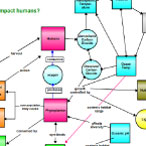Scientist Timothy Moore explains the concept map and its development:
My research interest is understanding how computer models can be used in concert with satellite-derived
measurements of ocean color to understand marine phytoplankton patterns. My original map addressed the question "Why are phytoplankton
relevant to humans?" This map was designed to show the high degree of connectivity between humans, atmosphere, oceans with -- of
course -- phytoplankton being important players. Phytoplankton are closely tied to many environmental resources (e.g., oxygen, nutrients,
fisheries, coral reefs) but also some environmental problems (e.g., "red tides," anoxia). Ocean-atmosphere exchange of carbon dioxide
determines the pH or acidity of the ocean. Global warming increases ocean temperature and melts ice sheets, both of which can contribute
to sea level rise.
Working with educators, we altered the focus question to: "Why do phytoplankton impact humans?" The map we created has many of the same
concepts as my original map but is rearranged to emphasize the "Human" element. For example, this map clearly shows that the oxygen
produced by phytoplankton is vital to humans but some algae can be harmful. The map also includes an abbreviated "marine food web" that
shows relationships among fisheries, zooplankton, phytoplankton, and coral reefs. To increase clarity, we placed the environmental
factors -- including atmospheric and ocean temperature, weather, ocean mixing, nutrients, carbon dioxide, and pH -- on the right half of the
map. We also "saw the light" and remembered to add this key "ingredient" for phytoplankton growth!
|












